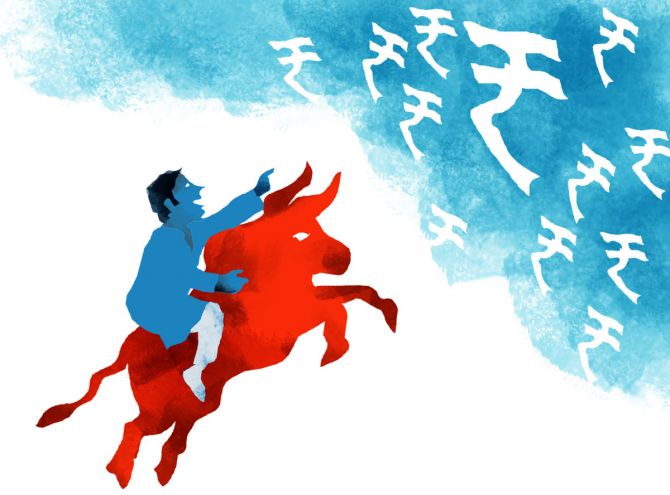A quaint Indian idea called face value is putting high-performing companies out of the reach of retail investors, observes Debashis Basu.

Just one share of MRF, a blue-chip listed tyre company, is trading at more than Rs 78,000. This makes a mockery of 'public listing' because it is mainly institutional investors which can buy a share with such a high unit value.
MRF is an extreme example because this Rs 18,000 crore turnover company has refused to issue bonuses or split its shares for the past 30 years at least. Regular bonuses and splits would have brought the unit value down maybe to a low four-digit figure.
But that would still not solve a huge problem that has been growing over the years and needs to be addressed soon. The problem is a quaint Indian idea called face value, which is putting high-performing companies out of the reach of retail investors.
Here is some data.
While one share of MRF is over Rs 78,000, that of Honeywell Automation is nearly Rs 46,000.
How about Page Industries, which a satisfied buyer of Jockey undergarments may want to buy, following the legendary investor Peter Lynch's advice of buying stocks arising from your own circle of knowledge and experience? A single share of Page is close to Rs 38,000.
Here are some other popular companies with high approximate unit values: 3M India (Rs 26,000), Abbott (Rs 23,000), Nestle (Rs 19,000), Bajaj Finserv (Rs 17,000), and Bosch (Rs 17,500).
At Moneylife we categorise companies as mega-caps, large-caps, mid-caps, small-caps, and micro caps. As many as 92 mega-cap companies and 85 large-cap companies -- segments that include many high-quality stocks that an average retail investor should be buying -- are trading at four-digit prices. This dampens our effort to widen retail participation and the problem will only get worse as time passes.
Under the Companies Act of 1956, Indian companies had shares with a face value of Rs 10 and in some rare cases, such as ACC, of Rs 100. At that time companies were allowed to convert their face value of Rs 100 into Rs 10.
In 1999, during the dot-com boom, tech companies convinced the market regulator and the finance ministry that India had been living the Stone Age and it was time we allowed stock splits and did away with face value. Companies were then allowed to split their face value into shares of either Re 1, Rs 2, or Rs 5, but the concept of face value remained stubbornly in place.
As an aside, at the height of the dot-com boom, Zee shares were spectacularly rigged up to Rs 1,500 (par value of Re 1), when it was quoting at a P/E of 250. The catchphrase those days was dus ka ek aur ek ka dus, meaning that the Rs 10 face value share would be split into 10 shares of Re 1 each and then each of these Re 1 shares would zoom up to Rs 10,000!
When the face value is split, the number of shares goes up by the same ratio, keeping the equity capital intact.
Some 20 years have passed and numerous companies have split shares, which reduced their unit value and increased their accessibility to retail investors looking for good-quality scrips. But a problem remained.
Outstanding companies, which retail investors ought to be buying, steadily improve their profits over time. Since stock prices follow earnings, the share price keeps rising. Atul Ltd was a three-digit stock in early 2014 (over Rs 400); it has now hit five digits.
It can split its stock down to Re 1 but the inherent problem of rising unit value will remain. Once a company has split its stock down to Re 1, it cannot split it any further.
The only other way to reduce unit value is by issuing bonus shares, but this increases capital and changes the capital structure, which may not be desirable.
We need to make the unit value of stocks smaller without changing the capital structure. The solution is obvious: Abolish the idea of face value.
Once face value is abolished, companies should be able to subdivide their capital into any number of shares.
Take the case of Bajaj Finance. Its stock is quoted at Rs 7,700 and it has an equity capital of Rs 120 crore, that is 600 million shares with a face value of Rs 2 each.
If face value is abolished, it will have the choice of dividing its Rs 120 crore capital into any number of shares. If it decides to have 6,000 million shares, the share price will be adjusted down to Rs 770, making it accessible to many more investors. It will not be a share that only large players can buy.
The question is not about accessibility alone.
More than 15 million new investors have entered the market in the past one year while prices of quality stocks have gone stratospheric. We need to give them the tools of sound investment strategy, the cornerstones of which are asset allocation and diversification.
You need to invest part of your surplus capital in equities for the long term and diversify across a larger number of shares.
Even if you have Rs 100,000 to allocate to equities, a fairly large sum even today, you cannot buy Bajaj Finance or, say, SRF (Rs 12,000 apiece) if you want to diversify across 25 stocks.
At the most, you can allocate Rs 4,000 to each stock, putting many quality companies out of your reach.
Abolishing face value will fix this core problem, widen share ownership, increase liquidity (which benefits even institutional investors), and bring India to the modern age.
Why hasn't such an obvious winning idea been implemented so far? Well, who thinks for the small investor?
Debashis Basu is the editor of www.moneylife.in.











